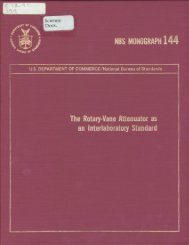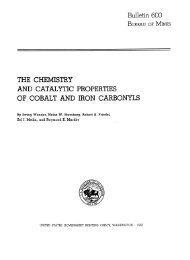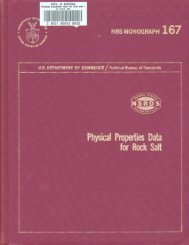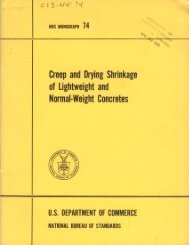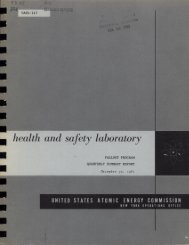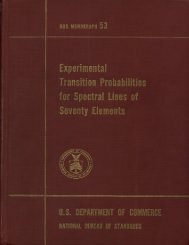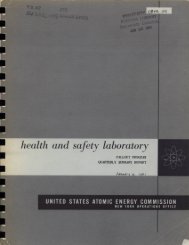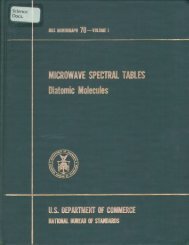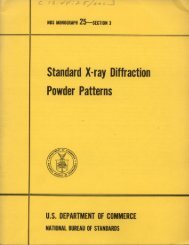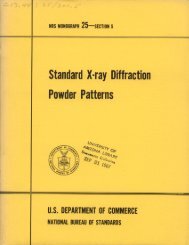LOVELACE FOUNDATION
LOVELACE FOUNDATION
LOVELACE FOUNDATION
You also want an ePaper? Increase the reach of your titles
YUMPU automatically turns print PDFs into web optimized ePapers that Google loves.
22/ f-F -5<br />
If?<br />
Li.<br />
_J<br />
<strong>LOVELACE</strong> <strong>FOUNDATION</strong><br />
for Medical Education and Research<br />
UNIVERSITY Of<br />
ARIZONA LIBRARY<br />
Docurne^ Collection<br />
FEB 25 1963 LF-5<br />
AEC RESEARCH AND<br />
DEVELOPMENT REPORT<br />
UNCLASSIFIED<br />
A CASCADE IMFACTOR OPERATING<br />
AT LOW VOLUMETRIC FLOW RATES<br />
by<br />
T. T. MERCER, M. I. TILLERY<br />
AND<br />
C. W. BALLEW<br />
Albuquerque, New Mexico<br />
December 1962<br />
ATOMIC ENERGY COMMISSION -<br />
<strong>LOVELACE</strong> <strong>FOUNDATION</strong><br />
FISSION PRODUCT INHALATION PROJECT
LEGAL NOTICE<br />
This report was prepared as an account of Government sponsored work.<br />
Neither the United States, nor the Commission, nor any person acting<br />
on behalf of the Commission:<br />
A". Makes any warranty or representation, express, or implied,<br />
with respect to the accuracy, completeness, or usefulness of<br />
the information contained in this report, or that the use of any<br />
- information, apparatus, method, or process disclosed in this<br />
report may not infringe privately owned rights; or<br />
B. Assumes any liabilities with respect to the use of, or for<br />
damages resulting from the use of any information, appara<br />
tus method, or process disclosed in this report.<br />
As used in the above, "person acting on behalf of the Commission 11 in<br />
cludes any employee or. contractor of the Commission to the extent that<br />
such employee or contractor prepares, handles or distributes, or pro<br />
vides access to, any information pursuant to his employment or con<br />
tract with the Commission,<br />
Printed in USA. Price $0. 50 . Available from the Office of<br />
Technical Services, Department of Commerce,<br />
Washington 25, D.C,
LF-5<br />
UNCLASSIFIED Instruments<br />
TID-45QO(18th Ed.)<br />
A CASCADE IMPACTOR OPERATING AT LOW VOLUMETRIC FLOW<br />
RATES<br />
by<br />
T. T. Mercer, M. I. TilleryandC. W, Ballew<br />
Submitted as a<br />
Technical Progress Report<br />
to<br />
The Division of Biology and Medicine<br />
United States Atomic Energy Commission<br />
on<br />
Contract No. AT(29-2)-1013<br />
December, 1962<br />
From the Section of Aerosol Physics<br />
Lovelace Foundation for Medical Education and Research<br />
Albuquerque, New Mexico<br />
UNCLASSIFIED
ABSTRACT<br />
3<br />
A five -stage cascade impactor, designed to operate at 50-150 cm /<br />
min, is described. The device comprises four impactor stages, in<br />
which round jets are used, and .a filter stage. The method of calibra<br />
tion of the instrument is described and it is shown that the curves of<br />
impaction efficiency as a function of the /^" are similar to those of large<br />
impactors of similar design, with /y = 0*29 for a collection efficiency<br />
= 0.5. For deposit thicknesses of 0.05 to 55.7 mg/cm , the wall losses<br />
vary between 1.4 and 9.8 per cent. The significance of the collection<br />
efficiency and wall losses with respect to sampling for mass distributions<br />
is discussed.
ACKNOW LEDGEMENTS<br />
The authors are indebted to Mr. Clarence Gailard for several<br />
valuable suggestions with respect to the design of the impactor.<br />
11
TABLE OF CONTENTS<br />
Page<br />
Abstract ........................................ i<br />
Acknowledgements ................................ ii<br />
Table of Contents ................................ iii<br />
List of Tables .................................... iii<br />
List of Figures ................................... iv<br />
Introduction ..................................... 1<br />
Description of the Impactor ........................ 1<br />
Design Considerations ..........*..*.*......... 1<br />
Operating Characteristics ..................... 3<br />
Calibration Methods ............................... 5<br />
Experimental Set-Up ......................... 5<br />
Determination of Efficiency .................... 7<br />
Determination of Wall Losses ................. 10<br />
Experimental Results ............................. 10<br />
Discussion ...................................... 12<br />
Summary ....................................... 17<br />
References ....................................... 19<br />
LIST OF TABLES<br />
Table 1<br />
Table 2<br />
Table 3<br />
Operating Characteristics of the Small<br />
Impactor ............................ 5<br />
Wall Losses for Various Sampling<br />
Conditions ............................ 12<br />
Sampling Errors in the Use of the<br />
Effective Cut-off Method ............... 17<br />
111
LIST OF FIGURES<br />
Figure<br />
1 Sectional Diagram of Cascade Impactor ... * 4<br />
2 Sampling Arrangement for Calibration<br />
of the Cascade Impactor ................ 6<br />
3 Collection Efficiency as a Function of<br />
./Y for the Impactor Jets ................ 11<br />
4 Wall Loss as a Function of the Deposit<br />
Thickness ............................ 13<br />
5 Effective Cut-off "Aerodynamic" Diameters<br />
for Each Stage as Functions of the<br />
Volumetric Flow Rate Through the<br />
Impactor............................. 15<br />
6 Separation of Sample Aerosol in the<br />
Impactor............................. 16<br />
iv
A CASCADE IMPACTOR OPERATING AT LOW VOLUMETRIC<br />
FLOW RATES<br />
by<br />
T. T. Mercer, M. I. Tillery and C. W. Ballew<br />
INTRODUCTION<br />
The cascade impactor is a valuable tool for use in experiments de<br />
signed to study the toxicity of airborne particulate material, because it<br />
provides a means for direct determination of the mass distribution of the<br />
aerosol under study. In the present case, highly radioactive aerosols<br />
are under investigation, and samples collected from large volumes of<br />
air cannot be tolerated. Since impactors described in the literature '<br />
C*7Q4/"\4O<br />
' * * operate at flow rates of 10 to 30 liters /minute, while one<br />
was needed which operated at 50 to 150 cm /minute, it was necessary to<br />
design the instrument described below.<br />
DESCRIPTION OF THE IMPACTOR<br />
Design Considerations. Ideally, one would like to have an impactor in<br />
which the curve of efficiency versus particle size for each stage was a<br />
step function, with the particle diameter at which the step occurred<br />
differing by a factor of about two from one stage to the next. One would<br />
also like to have negligible wall losses in the impactor.<br />
Davies and Aylward have shown on theoretical grounds that the<br />
efficiency of the impaction process for rectangular jets is a function of<br />
two dimensionless quantities; the inertial parameter, Y> of the particle,<br />
and the ratio of the jet-collector separation, S, to the jet width, W. The<br />
parameter y is given by<br />
pD2U C
where p is the particle's density, D is its diameter, U is the velocity of<br />
the air stream as it emerges from the jet, t) is the viscosity of the air,<br />
and C is the slip factor. For present purposes, the following expression<br />
4<br />
for C is convenient:<br />
where p is the atmospheric pressure in cm of Hg, and D is the particle's<br />
diameter in microns. The quantity, /y, which is proportional to D, is<br />
more commonly used than Y. Davies and Aylward obtained theoretical<br />
curves of efficiency as a function of /\jTfor a number of values of S/W.<br />
These showed that as S/W decreased, there was a decrease in the value<br />
of ,/y" for which the efficiency, E, was 0. 5, and an increase in the slope<br />
of the curve at that point. At low values of S/W, the theoretical efficiency<br />
curve was almost a step function.<br />
8<br />
The original cascade impactor described by May employed rectan<br />
gular jets, as did those described subsequently by Sonkin , L*askin ,<br />
Wilcox , and Lippman . Ranz and Wong described a single stage<br />
impactor having a rectangular jet. In those cases in which the data can<br />
be interpreted in terms of the theory of Davies and Aylward* there is<br />
Q<br />
evidence that ,/y (E = 0.5) decreases as predicted with decreasing S/W ;<br />
however, for a given value of S/W, the experimental efficiency curves<br />
show a reduction in slope as E approaches 1.0.<br />
Impactors using single round jets have been described by Ranz and<br />
Wong , and Mitchell and Pilcher , and one in which each stage in<br />
cluded several hundred round jets was described by Andersen . Ranz<br />
and Wong obtained a theoretical curve for the case in which, in effect,<br />
S/W = 0,5. While additional theoretical work is lacking, experimental<br />
work indicates that the effect of S/W for round jets is qualitatively<br />
similar to that for rectangular jets. Moreover, Mitchell and Pilcher<br />
found that for S/W = 0. 375, the efficiency curve was very nearly a step<br />
function.<br />
Because of the advantages to be expected with respect to collection<br />
efficiency, and because round jets are relatively more easy to machine,<br />
especially in the small sizes required in this case, it was decided to<br />
-2-
design and construct a cascade impactor using a series of round jets.<br />
The problem of wall losses is a serious matter with cascade impactors.<br />
They have been found to be quite high in rectangular jet impactors<br />
' . Mitchell and Pilcher found it was necessary to provide<br />
quite large distances between the edge of the collector plate and the wall<br />
of the impactor in order to reduce wall losses to acceptable levels.<br />
Andersen , on the other hand, found wall losses to be negligible. Since<br />
in all impactors the linear velocity with which the air flows between jets<br />
is certainly much less than the linear velocity through the previous jet,<br />
it seems likely that wall losses are due to effects of turbulent flow be<br />
tween jets. In the irnpactors mentioned, except the Andersen, abrupt<br />
changes in the cross-sectional area of the air passage occur immediately<br />
after the air leaves the jet. For this reason, the present impactor was<br />
designed to minimize all such changes.<br />
Operating Characteristics. The impactor is shown schematically in<br />
Fig. i. The collector plates are 22-mm diameter glass cover slips.<br />
They are kept at the proper distance from the jet by three spacers of<br />
about 1-mm diameter set on a 5/8" circle about the jet and having lengths<br />
as shown in Table 1. Three stainless steel wire (11-mil) springs hold<br />
the collectors firmly in place. The use of the O-rings prevents any leak<br />
age of air around the stages. The two I/ 16"-diameter pins, soldered into<br />
the first stage, fit through appropriate holes in each of the following<br />
stages to prevent lateral movement of the stages when assembling or<br />
disassembling the impactor* The overall dimensions of the impactor,<br />
not including the inlet and outlet tubes, are 2-1/8" diameter by 2" long,<br />
The jet diameters, spacer lengths, and linear air velocities through the<br />
jets are shown in Table 1. ,
Support Springs<br />
SECTIONAL<br />
DIAGRAM OF<br />
CASCADE IMPACTOR<br />
Aerosol Entry<br />
Cover Plate<br />
Outer Housing<br />
0 Rings<br />
Aligning Pin<br />
et-Collector<br />
Spacers<br />
Slips<br />
.Cover Slip<br />
Supports<br />
0 Ring Membrane Filter<br />
Vacuum Applied<br />
SECTION "A-A"<br />
Fig. 1
TABLE 1. Operating Characteristics of the Small Impactor<br />
aj*.<br />
1<br />
2<br />
3<br />
4<br />
Jet diameter,<br />
W<br />
.081 cm<br />
.053 "<br />
.033 "<br />
.016 "<br />
Spacer<br />
length, S<br />
.030 cm<br />
.020 "<br />
.013 "<br />
.006 »<br />
S/W<br />
turn UN fi i<br />
.37<br />
.38<br />
.39<br />
.38<br />
Linear air<br />
velocity<br />
through jet*<br />
3. 21 F cm/sec<br />
7.44F<br />
19*49 F "<br />
82.80F<br />
#F = Total volumetric flow rate through the impactor in cm /rnin<br />
While the impactor referred to in Table 1 was the one of primary<br />
interest because of the low volumetric flow rate, a second was constructed<br />
which differed only in the jet diameters and spacer lengths. These were<br />
each 2.7 times the values shown in Table 1, so that at one liter/min the<br />
second impactor had linear velocities through the jets similar to the<br />
first impactor operated at 150 cm /min. In the following, the first is<br />
identified as impactor 1, the second as impactor 2.<br />
CALIBRATION METHODS<br />
Experimental Set-up. The instrument was calibrated in terms of the<br />
collection efficiency as a function of v/y, since it was intended to use the<br />
Q<br />
effective cut-off method in the interpretation of sampling data. The<br />
experimental arrangement for collecting the samples for calibration is<br />
shown in Fig. 2.<br />
Two types of aerosols were used. One was produced by atomization<br />
of liquid stearic acid, using an aerosol generator similar in principle to<br />
that described by Lauterbach et.al. . Upon mixing with the diluting air,<br />
the stearic acid particles solidified, giving an aerosol of essentially<br />
spherical particles of a wide range of sizes. The other aerosol was pro<br />
duced by means of a similar generator atomizing a suspension of poly<br />
styrene latex particles. In one case, particles of 0. 365 micron diameter*<br />
were used in a dilution of 1:3000. Electron micrographs of these<br />
^Obtained from the Dow Chemical Co., Midland, Mich.<br />
'.5.
Hood Exhaust<br />
(c3.<br />
Quick<br />
Disconnect<br />
Valve<br />
Vacuum<br />
i Rotameter<br />
Filtered, Dry,<br />
Diluting Air<br />
Compressed Air<br />
Aerosol<br />
Generotor<br />
~--Aerosol Solution<br />
Fig. 2<br />
Sampling Arrangement<br />
for Calibration of the<br />
Cascade Impactor
particles indicated that the mean diameter was as stated. Particles,<br />
nominally of 0*81 micron diameter*, were also used, in a dilution of<br />
1:2000, However, measurements made on electron micrographs of a<br />
sample collected by electrostatic precipitation gave an average diameter<br />
of 0.73 micron with a relative standard deviation of + 5 per cent. Some<br />
of the particles had a slightly elliptical appearance so three measurements<br />
were made on each particle and averaged: two, mutually perpendicular,<br />
were made on the particle itself, and a third was made on the length of<br />
the shadow which had been cast at 30 . The aerosols obtained with poly<br />
styrene particles were made up predominantly of single spheres, although<br />
doublets-, triplets, and occasionally particles of several unit spheres<br />
were observed. As will be seen below, however, these did not affect the<br />
determination of efficiency.<br />
For a given set of conditions, the flow rate was set by means of the<br />
rotameter. The impactor inlet was then connected to a one-liter spirometer<br />
and the flow rate determined by measuring the time required to<br />
evacuate a given volume of air from the spirometer. Sampling was then<br />
begun and ended by the use of the quick-disconnect valve.<br />
Determination of Efficiency. Two samples of the same aerosol, col<br />
lected at the same flow rate, were necessary to make a determination of<br />
efficiency. Schematically, the samples were arranged in the following<br />
manner:<br />
First Sample<br />
Jet A Jet B<br />
N<br />
Efficiency =<br />
Efficiency =<br />
NA = EAW No<br />
.*Obtained from the Difco Co., Detroit, Mich.<br />
-7-
Second Sample<br />
Jet B Jet A<br />
N<br />
- EB> No<br />
Efficiency = EB<br />
NB'= EB NO<br />
In collecting a sample, two jets were arranged in series in the impactor*<br />
Similar jets from two impactors were used in most cases; however, as<br />
the efficiency diminished it was necessary to use adjacent jets from the<br />
same impactor, with the jet designated as B having the smaller orifice.<br />
For the first sample, the collector behind jet A was coated with an<br />
adhesive; that behind jet B was left dry* (The adhesive used was Dow<br />
Aerosol Anti-Foam A, a silicone product. It was used initially because<br />
it was available; however, it was found to give a satisfactory adhesive<br />
that could be readily applied from the spray can in a uniform, viscous<br />
layer.) After the first sample was collected, the cover slips were re<br />
placed, the positions of the jets were reversed, and a second sample was<br />
collected in the same way.<br />
The efficiency of jet A when operated with an adhesive coating on the<br />
collector could then be determined in the following way. Let N be the<br />
number of particles of a given size entering the front jet during the<br />
sample. Let the efficiency of jet A, with adhesive, be E A w and of jet<br />
B, without adhesive, be E->. For the first sample, the number of<br />
j<br />
particles collected by jet A is<br />
N A = E A , Ar N<br />
A AW o<br />
and the number collected by jet B is
For the second sample, the number collected by jet B is<br />
NB* = EB No<br />
N<br />
The ratio NB /NB ' = ^EAW> from which EAW = 1 - fT-v For a<br />
B<br />
run, all the particles were counted within a rectangle having a width be-.<br />
tween 0.4 and 1. 6 mm, depending on the jet diameter, and a length equal<br />
to the diameter of the cover slip, and having its center at the center of<br />
the deposit* This yielded numbers proportional to NR and N', Actually,<br />
the numbers were very nearly equal to NR and N ', since the particles<br />
were very heavily concentrated under the jet.<br />
This derivation assumes that no particles are lost between jets and<br />
that N and E^ do not vary between samples* That the first assumption<br />
is reasonable is shown by the low wall losses (see below). Changes in<br />
N would require changes in the aerosol output during the length of time<br />
needed to complete two samples. Since the time from the start of the<br />
first run to the end of the second was always less than five minutes,<br />
changes in N were unlikely * The consistency of the results indicate<br />
that changes in E B are negligible.<br />
All counting and measurements were made using an oil immersion<br />
objective (overall magnification ^900x). For the stearic acid samples,<br />
measurements were made using an eyepiece micrometer and only<br />
particles larger than 3 divisions (3.4 |ji under the conditions indicated)<br />
were included.<br />
For stearic acid particles, the root inertial parameter is<br />
- 2 33 v 10"4D /^<br />
~~ t*» j j jv A \j ^rT* v ^^^n^<br />
for F the volumetric flow rate in cm /min, W the jet orifice diameter in<br />
cm, D the particle diameter in microns, and C as defined above. For<br />
polystyrene particles the parameter is<br />
-9-
For a given jet and particle size, changes in /y were brought about by<br />
varying F. ,<br />
Determination of Wall Losses.<br />
Wall losses were determined by using the impactor to sample an<br />
24<br />
aerosol of sodium chloride containing the radioactive isotope Na . Two<br />
methods of measurement were used. In one, the impactor was prepared<br />
for sampling and then its gamma ray background was determined using a<br />
2 11 x 2" Nal(Tl) crystal. A sample was then collected, after which the<br />
impactor was returned to the counter and its gamma ray emission mea<br />
sured again in the same geometry. The collecting cover slips and the<br />
filter were then removed, the impactor was reassembled, and counted a<br />
third time in the same geometry. The ratio of the difference between the<br />
first and third counts to the difference between the first and second counts<br />
represented the wall loss.<br />
In the second method, the impactor was washed, dried, and used to<br />
collect a sample. Each collecting cover slip, the cover slip holder, and<br />
the stage itself, top and bottom, were counted for beta activity using a<br />
thin crystal [CsI(Tl)] counter. With the exception of the concave side of<br />
the jet stage, all counting was in essentially the same geometry. By<br />
counting a plane source at the minimum and maximum distances encoun<br />
tered with the jet stage it was found that the geometry could not effect a<br />
counting loss greater than 4 per cent. The wall loss for this method<br />
was calculated as the ratio of the beta counts not on collectors to the<br />
total beta counts.<br />
EXPERIMENTAL RESULTS<br />
Since the design of all jets was aerodynamically similar, the results<br />
for all four have been plotted on a single curve in Fig. 3. The value of<br />
/\p for which E = 0. 5 appears to be 0. 29.<br />
The results of the measurements of wall loss are shown in Table 2.<br />
The total sample in micrograms was calculated from the observed activ<br />
ity of the sample and the activity and mass concentrations of the gener<br />
ator solution. The samples marked with an asterisk were taken with the<br />
diluting air inadvertently left off. In this case, the aerosol was collected<br />
in droplet form, causing unusually heavy deposits. The average deposit
-II-<br />
OQ<br />
Collection Efficiency<br />
O ~ 01 o o<br />
o o<br />
n<br />
rf<br />
o'<br />
M t-S<br />
t-S<br />
H»<br />
O<br />
ro<br />
w<br />
*J<br />
0<br />
CD<br />
< O > O<br />
It II tt II<br />
CD CD (0 CD<br />
4^ — PO OJ<br />
oi-i<br />
t s<br />
1 §.<br />
>c o"<br />
CD ^><br />
en -*•<br />
v:<br />
CD<br />
O 'n-<br />
O<br />
Q n-<br />
w
thickness in mg/cm was calculated by dividing the total deposit by the<br />
total croes-sectional area of all the jets.<br />
In Fig. 4, the wall losses are plotted against the logarithm of the<br />
deposit thickness in mg/cm . Although no specific quantitative signifi<br />
cance is attached to the straight line drawn through the points, it serves<br />
to bring out the existence of a relationship between wall losses and<br />
deposit thickness.<br />
The wall losses occurred mainly around the orifices of jets 3 and 4,<br />
on the exhaust side, and with heavy deposits were visible as rings about<br />
the orifices. Losses to other surfaces amounted to only a fraction of a<br />
per cent.<br />
TABLE 2. Wall Losses for Various Sampling Conditions<br />
Sampler<br />
2<br />
1<br />
2<br />
1<br />
2<br />
1<br />
2<br />
1<br />
2<br />
Flow rate<br />
3, .<br />
cm /mm<br />
1050<br />
53<br />
1050<br />
137<br />
860<br />
137<br />
860<br />
53<br />
860<br />
Total<br />
sample, |j.g<br />
11.8<br />
.158<br />
0.5<br />
36.8<br />
2160*<br />
205*<br />
328<br />
467*<br />
28.3<br />
Deposit<br />
mg/cm<br />
0.20<br />
0.06<br />
2.62<br />
4.38<br />
35.9<br />
24.5<br />
5.44<br />
55.7<br />
3.37<br />
Wall losses<br />
per cent<br />
2.5<br />
1-4<br />
3.5<br />
6.2<br />
6.7<br />
5.8<br />
5.6<br />
9.8<br />
4.6<br />
DISCUSSION<br />
Although the values of S/W for the various jets (see Table 1) differed<br />
slightly from the value of 0. 375 used by Mitchell and Pilcher , the<br />
curve shown in Fig. 3 is almost identical to the one they obtained for an<br />
impactor operating at 12 liters/min. Considering the marked difference<br />
between the two impactors with respect to physical dimensions and<br />
volumetric flow rates, this lends strong support to their statement that<br />
if round jets are properly machined with respect to W and S/W values,<br />
the calibration for one is adequate for all.<br />
The curve of Fig. 3, of course, is the basis for interpreting sampling<br />
-12-
10<br />
9<br />
8<br />
c 7<br />
0)<br />
S. 6<br />
to<br />
I<br />
« 5<br />
o»<br />
3<br />
i 3<br />
o = Impacfor I<br />
o s Impactor 2<br />
»L5 *I.O -0.5 0 0.5 10 1.5<br />
2.0<br />
Log [Deposit Thickness in mg/cm 2 J<br />
iFig. 4, Wall Loss as a Function of the Deposit Thickness
data taken with the impactor. In the present case, the quantity/p C D is<br />
of most interest. For a given jet and flow rate, particles having equal<br />
values of v/pTc D will be collected with equal efficiencies. Such particles<br />
will also have equal settling velocities, provided laminar flow prevails*<br />
Hence, the quantity /pC D is of particular interest with respect to the de-<br />
p^sirion of inhaled particles in the respiratory tract. It will be referred<br />
to hereafter as the uaerodynamic diameter" of the particle, although the<br />
definition of that term has not always included fC* In using the impactor<br />
to determine the particle size distribution of an exposure aerosol, the<br />
cumulative per cent mass up to, and including, a given stage, is plotted<br />
against the value of >/p C D for which /y for that stage equals 0. 29, using<br />
logarithmic-probability paper. In this way a mass median aerodynamic<br />
diameter is obtained. Fig. 5 shows the values of these effective cut-off<br />
aerodynamic diameters for each stage of impactor 1 for values of F be-<br />
3<br />
tween 50 and 150 cm /min.<br />
Even if wall losses did not occur, the use of the effective cut-off<br />
method of interpreting impactor data would introduce errors due to the<br />
fact that the efficiency curve is not a true step function* The effect of<br />
these errors on the determination of the particle size distribution of an<br />
9<br />
unXr jwn aerosol has been discussed for an impactor having round jets<br />
exhibiting an efficiency curve such as that of Ranz and Wong . In the<br />
present case, the marked improvement in the efficiency curve reduces<br />
the magnitude of the error. The manner in which the mass of a sample<br />
from an aerosol having a mass median aerodynamic diameter of 1. 0 and<br />
a geometric standard deviation of 2.0 would be distributed among the<br />
2<br />
stages of impactor 1, when operated at 150 cm /min without wall losses,<br />
is shown in Fig. 6. The effective cut-off points are indicated. For each<br />
stage, the upper hatched area represents the mass assumed to be collected<br />
when it is not and the lower hatched area represents the mass assumed<br />
to escape when actually it is collected. The magnitude of the errors in<br />
volved is shown in Table 3. While the total hatched area is in error,<br />
only the difference between the upper and lower areas contributes to the<br />
error in estimating the particle size distribution.<br />
-14-
0.5<br />
0.4<br />
0)<br />
I 0.3<br />
0.2<br />
O.I<br />
50 60 70 80 90 100 110 120<br />
130 140 150<br />
Fig. 5.<br />
Flow Rate in cm 3/min<br />
Effective Cut-off "Aerodynamic" Diameters for<br />
Each Stage as Functions of the Volumetric Flow<br />
Rate Through the Impactor.<br />
-15-
-91-<br />
Relative Mass Frequency<br />
en<br />
CD<br />
^<br />
&><br />
4<br />
£o'<br />
2<br />
0<br />
iCD<br />
><br />
CD<br />
H<br />
O<br />
0)<br />
O<br />
CD<br />
3<br />
X3<br />
P<br />
O<br />
r+<br />
O
TABLE 3. Sampling Errors in the Use of the Effective Cut-off Method<br />
Stage<br />
1<br />
2<br />
3<br />
4<br />
Cumulative mass<br />
fraction collected<br />
0.133<br />
0.415<br />
0.796<br />
0.995<br />
Mass fraction<br />
in shaded areas<br />
0.0074<br />
0.0162<br />
0.0165<br />
0.0029<br />
Relative<br />
mass error<br />
in per cent<br />
5.6<br />
3.9<br />
2. 1<br />
0.3<br />
Effective<br />
error in<br />
per cent<br />
0.86<br />
0. 11<br />
0.04<br />
0.007<br />
In order for results such as those shown in Table 3 to apply in practice,<br />
it is necessary that the impactor be operated under conditions similar to<br />
those in effect when the efficiency curve of Fig. 3 was obtained. In par<br />
ticular, the thickness of the deposits in the various stages must be small<br />
enough not to alter the $/W values. This limits the deposit on stage 4 of<br />
impactor 1 to about 1 mg/cm , which effectively restricts the use of that<br />
impactor to the sampling of aerosols which can be readily analyzed in<br />
small mass quantities, e.g., aerosols of radioactive substances of re<br />
latively high specific activity. This restriction becomes less stringent<br />
as the jet diameters increase.<br />
The observed wall losses were considerably less than those re-<br />
3 7<br />
ported for rectangular jet impactors ' . They are comparable to the<br />
losses reported by Mitchell and Pilcher . The fact that the losses<br />
occurred mainly around the third and fourth jets, where the jet-collector<br />
separation, S, is very small, suggests that impactors operating at higher<br />
volumetric flow rates, and thus having larger values of W and S, might<br />
show smaller losses of this type. However, it is not known to what<br />
extent higher flow rates might introduce more pronounced wall losses of<br />
the conventional type*<br />
SUMMARY<br />
A five-stage cascade impactor comprising four round jets and a<br />
filter stage and operating at volumetric flow rates of 50-150 cm /min<br />
has been described. The design provided aerodynamic ally similar con<br />
ditions at each stage. The ratio of the jet-collector separation, Si to<br />
the jet orifice diameter, W, was maintained between 0. 37 and 0. 39.<br />
Abrupt changes in geometry, which could lead to turbulent flow between<br />
.-17-
jets with consequent high wall losses, were avoided.<br />
The impactor was calibrated in terms of collection efficiency as a<br />
function of the root inertial parameter, /\j^ It was found that the results<br />
for all four jets fitted a single curve, which was almost identical to the<br />
curve reported by Mitchell and Pilcher for aerodynamic ally similar<br />
jets operating at 12 liters /min.<br />
*<br />
The value of /^corresponding to a collection efficiency of 0. 5 was<br />
found to be 0.29* The effective cut-off "aerodynamic 11 diameters for each<br />
stage were calculated for volumetric flow rates between 50 and 150<br />
cm- /min. The errors introduced when these diameters are used to<br />
determine the distribution parameters of an unknown aerosol have been<br />
discussed.<br />
For a range of average deposit thicknesses between 0.06 and 55.7<br />
mg/cm , the total wall losses were found to vary between 1.4 and 9*8<br />
per cent. The losses occurred mainly around the orifices of jets 3 and<br />
4, on the exhaust side. The need for keeping sample masses low,<br />
effectively limits the use of the impactor to aerosols of materials for<br />
which highly sensitive analytical methods are available, e.g., radio<br />
active materials of relatively high specific activity.<br />
-18-
REFERENCES<br />
1. Andersen, A. A, New sampler for the collection, sizing and<br />
enumeration of viable airborne particles. J. Bact. 76:5, pp<br />
471-484 (1958)<br />
2. Davies, C. N. 'aiuj'lyt? Aylward. The trajectories of heavy,<br />
solid particles in a two*dimensional jet of ideal fluid impinging<br />
normally upon a plate. Proc. Phys. Soc. B 64:889-911 (1951)<br />
3. First, Melvin W. Instrumentation for particle sizing, Encyc.<br />
Inst. Industr. Hyg. Ed. by Charles D. Yaffe, Dohrman H. Byers,<br />
and Andrew D. Hosey. University of Michigan (1956)<br />
4. Green, H. L. and W. R. Lane. Particulate clouds: dusts, smokes,<br />
and mists. E. and F. N. Spon Ltd. , London (1957)<br />
5. Laskin, S. Pharmacology and toxicology of uranium compounds.<br />
Ed. byC. Voegtlin and H. C. Hodge, Vol. JU pp 463-505.<br />
McGraw-Hill Book Co., New York City (1949)<br />
6. Lauterbach, K. E. , A. D. Hayes and M. A. Coelho. An improved<br />
aerosol generator. A.M.A. Arch. Industr. Hyg. 13:156-160<br />
(1956)<br />
7. Lippman, M. A compact cascade impactor for field survey<br />
sampling. A.I.H.A.J. 22:5, pp 348-353 (1961)<br />
8. May, K. R. The cascade impactor: an instrument for sampling<br />
coarse aerosols. J. Sci. Inst. 22, pp 187-195 (1945)<br />
9. Mercer, T. T, On the; calibration of cascade impactors. Ann.<br />
Occup. Hyg. £:1 pp 1-14 (1963)<br />
10. Mitchell, R. I. a,nd J. M- Pilcher. Design and calibration of an<br />
improved cascade impactor for size analysis of aerosols. Proc.<br />
Fifth A. E.G. Air Cleaning Conf. TID-7551, pp 67-84, OTS Dept<br />
of Commerce, Washington D. C. (1958)<br />
11. Ranz, W. E. and J. B* Wong. Impaction of dust and smoke<br />
particles on surface sgad body collectors. Industr. Eng. Chem.<br />
44:1371-1381 (1952) ,<br />
12. Sonkin, L. S. A modified cascade impactor. A device for<br />
sampling and siting aerosols of particles belpw one micron in<br />
diameter. J. Industr. Hyg. and Toxicol. 2£, 269 (1946)<br />
13. Wilcox, James D. Design of a new five*stage cascade impactor.<br />
A.M.A. Arch. Industr. Hyg. Occup. Me



